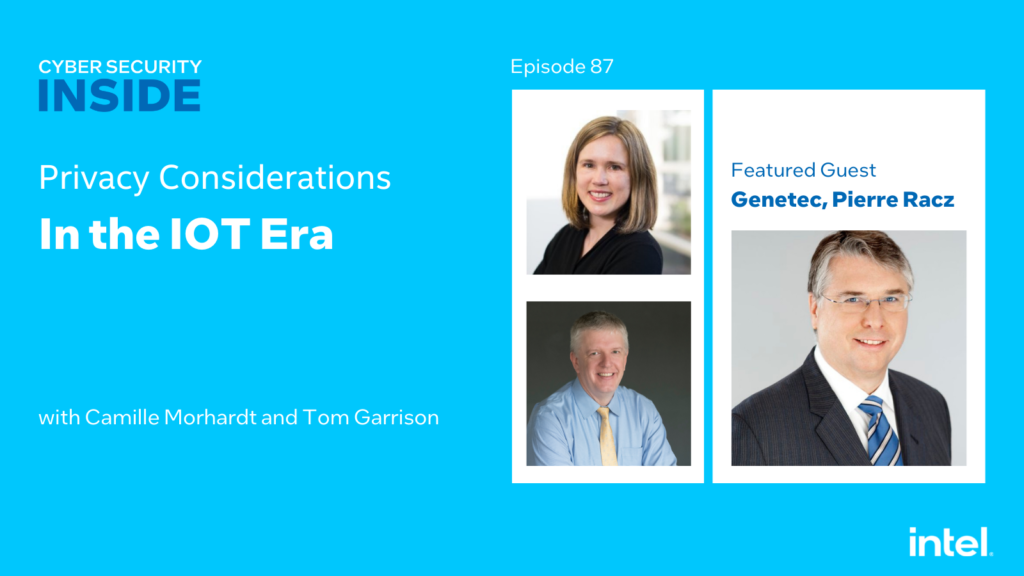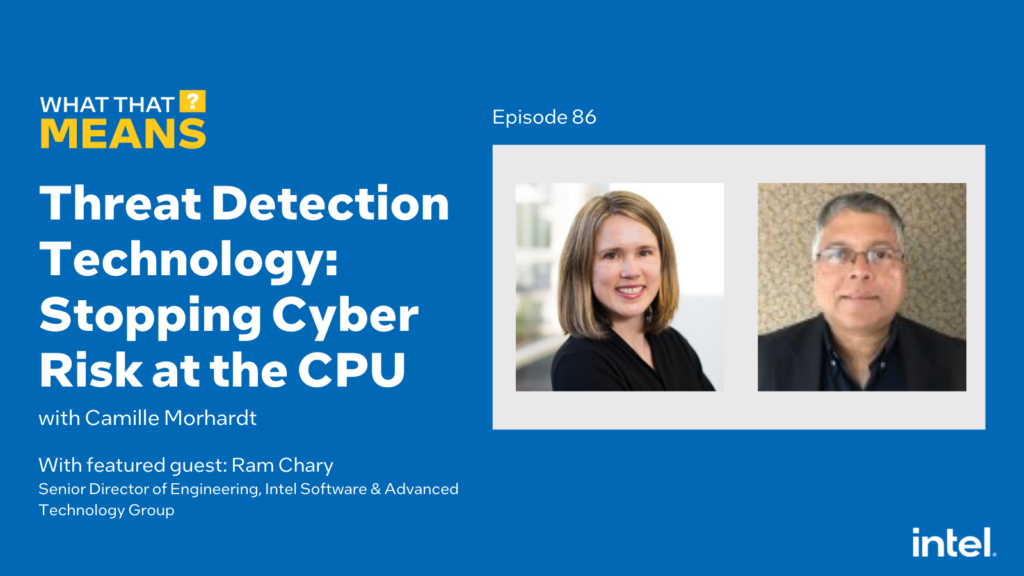[00:00:41] Camille Morhardt: Hi and welcome to today’s episode of Cyber Security Inside. I’m your host, Camille Morhardt and Tom Garrison is with me here; your other host. We are very fortunate today to be continuing with “Live from the Greenroom,” our special episode, we’re doing in partnership with AI Everywhere Conference at Intel.
And this is where we grab the key speakers out of the conference in between the activities that they’re participating in and dive a little bit deeper with them. So we’re happy right now that we have Itay Yogev with us. He’s VP and GM of AI for IT at Intel. Welcome to the show Itay.
[00:01:19] Itay Yogev: Hi Camille, Good morning. Nice to be on your show, it’s a great podcast. Fortunate to be part of it today.
[00:01:27] Camille Morhardt: Can you help us kick off here by understanding what is the VP/GM role of AI at IT in a major company; we’re going to call Intel a major company.
[00:01:41] Itay Yogev: I’m the guy that is in charge to use AI technology and use that insight, in turn, to transform basically how Intel runs. We have three big things in our team: one is trying to build internal startup to disrupt the critical efforts of the company–how we develop products, how we go about manufacturing, anything else that has direct impacts on sales. That’s one big chunk of the work. The second thing is AI Everywhere that we’ve just been a part of this conference and what it is, it’s time to go for the, what we call the “long tail” of AI everywhere in the company. The third thing is trying to help Intel win on AI. We can provide for Intel a lot of insights about what people like us in other company really needs in terms of hardware and software for AI to get our work done. We are focusing a lot on that, working together with our business units, partners in the company.
[00:02:38] Tom Garrison: That sounds good. So Itay, what areas have you found that were surprises for the people within the company? Like they didn’t think about AI this way and now that their eyes have been opened to the possibility of AI, it really transforms the way they think about the possibilities in the future. Do you have any kind of those examples here that you could share?
[00:03:01] Itay Yogev: I do. I think for many people AI is like a crystal ball. People either think it’s a hype or it can solve everything; but like in many other case of technology we are somewhere in between in the middle. And what I think is surprising for a lot of people that AI is not a futuristic thing. It’s already happening here inside Intel a lot. And it could be implement to get the work done better, not replacing the human beings, but walking alongside of human beings and solving problems for the company.
Today, just to give you one example, we know how to take algorithms and put them into our Intel chips to make our hardware smarter, more adaptive to the user’s needs. That’s something that we even did not envision, and so our counterparts in the Intel design organization, few years back, we didn’t assume we would be able to do something like that.
[00:04:01] Camille Morhardt: Are you also analyzing data, are you doing products or data that like work habits or practices in aggregate that employees are generating? What kinds of insights are you looking for in addition to adding into the CPU?
[00:04:18] Itay Yogev: The CPU example , Camille, was one of like 10 different verticals or startups that we have inside Intel. But we are also doing a lot on improving the quality of Intel’s products. Quality is a big thing in a physical hardware device and being able to find bugs in our silicone products is a very difficult mission. These are super complex products. We have a lot of engineers trying to find bugs before we go into what we call PLQ when the product is ready and we launch it into a mass production.
And we have came up for example, with a lot of technologies that imitates what human beings are tying to do to find bugs and try to do that without just the humans alongside of the humans and in the last big Intel product Alder Lake, which we’ve launched this year, we could found with AI 20% of the overall bugs that were found. And by that improve the quality of the product.
We work on the sales and marketing division. We’ve created what we call Sales AI or sales assists. This is an AI platform that tries to imitate the way that human salespeople would analyze information, read about customers, go to the websites, try understand what they really need and try to apply the same judgment and provide to these sellers actionable insights in a natural language, English that they could really read and understand. It’s like their personal assistant. It saves tons of time for them and make sure they’re not missing a bit about the customer needs. So these are two examples of different places in the company where we apply AI.
[00:05:56] Tom Garrison: From your position, I’m always interested to ask about the future and what you see happening over the next, say three, five years? Can you paint a picture for what the future looks like? What we’ll be able to do down the road that we can’t do today, and just help us get excited about what’s about to happen.
[00:06:19] Itay Yogev: So, first of all, I’m thankful you didn’t ask me a decade or two, because that is a difficult question that really nobody knows what is the limit of machines? What will machines be able to do compared to what people are capable of today? We usually look at it as the judgment that machines can apply today, which is pretty narrow compared to what human beings can apply in terms of judgment. Judgment are like problems that you are not sure what they are, I think it’s pretty soft; it’s not something that you could actually formulate in a way that then of course machine can do much better.
So a decade from today, we don’t know, or two, what is the limit for a machine? How broad of a general kind of judgment machines will be able to apply to solve problems currently, only humans are solving. What we know for sure that in the next three to five years, we could make like a 10x bigger impact inside Intel with AI in terms of reliving what we call the human bottleneck, by building smarter and smarter AI tools that are partnering with our engineers and becoming like a factor for them to get the work way more productive. For example, if I talked about finding 20% of the bugs, we have a target to find 50% of the bugs by AI within three years.
I referred to the sales example earlier.Ttoday with make we’re making an impact. this year of $300 million. We have a target of annual interest of revenue of $1 billion by 2024. So a lot of significant acceleration to the impact. And beyond that, there are questions that I referred to about a broader judgment that we are thinking of how can machine apply in solving bigger, more creative kind of tasks.
[00:08:17] Camille Morhardt: Really fascinating. How are you balancing this kind of personalization of AI? In particular, when you’re getting down to assist one engineer or one sales person with what they would do, kind of the personalization that that might require, and then the privacy on the other side of that coin.
[00:08:37] Itay Yogev: So for us, privacy matters a lot. People that are in the AI field and are aware of its power and what the future looks like, they really should care a lot about it. We are lucky to work in a company that they’ve established a program that is ensuring an ethical AI.
Most of what we do deals with very low levels of abstraction, like in the CPU firmware or a low-level software. So we are not all in the factory’s machines that are so ?? Inside Intel battled a lot with these day-to-day problems of privacy or ethical when it gets to providing decision support tools to engineers, to sales people, we’re making sure we are not using any of their personal information. We’re making sure we’re not breaking any of ethical rules regarding the information we collect or use, to ensure we can provide an objective aid or a decision tool to the people that actually do the engineering work inside the company.
[00:09:45] Tom Garrison: Do you find that that employees generally speaking, not the ones that are just knee deep in AI, but generally speaking, do you find that people are accepting of the idea of AI? Or do you think that there is trepidation and concern like, “oh, is this Skynet?” or those kinds of things?
[00:10:05] Itay Yogev: So I think 2 to 3 years back, there was a lot of concerns or even people resented or were struggling to accept the fact that AI is becoming a thing in the day-to-day life at the workplace; at home, it’s already happened to us. We are relying on that, but inside the workplace, there was a lot of resistance to this change a few years back. We are over that today at Intel; we are no longer dealing with resistance to that technology.
So I think that now the challenge is becoming more on how much can I rely on these systems and solutions that are becoming more and more intrusive and make sure that humans can still retain high degree of control on things that we want humans to control–things like ethics and privacy, but also on strategy and making sure that the algorithms, the solution we put in production are a reflection of the Intel strategy.
So I think that now it’s no longer resisting, it’s more about “let’s make it the right way, let’s make sure that machines can work together with humans to achieve a greater good for the company,” and to make them more productive.
[00:11:24] Camille Morhardt: What changed about the resistance? Why did that change?
[00:11:28] Itay Yogev: It works. When you bring something new to people that worked for 20 years, they know how to get things done in a certain way. And then you come with a new thing that many times requires some change on their side and it created some resistance. Does it work?
There’s another thing with AI that is very relevant to things related in manufacturing. Manufacturing people like to see a picture, they want to see a root cause, they want to understand the physics of things; with AI we are not always sure we can explain things the same way. We just have an evidence of millions of units behaving in a certain way, and therefore you could do something with it. So it was a change of paradigm for many people. To my point, when it works over time and yields value, it creates an appetite for more.
I spoke a little bit about manufacturing, one of our flagship projects for this year we are trying to significantly cut the test time for ever unit before we are shipping to customers, but without having any negative impact on Intel’s quality. So how could you cut the test time you invest on every unit to ensure that you are not making a negative quality impact? And this is like a very inclusive cutting edge technology AI that we have developed together with the manufacturing and the design organization. And this is like a huge leap of faith from their side on the value and that’s because they’ve seen a lot of value in the previous years of smaller incremental solutions.
[00:13:02] Tom Garrison: Yeah, I think of AI is one of those things where the more AI can take away mundane tasks that people don’t really like to do anyway and let them focus on real value-added areas–and also point people towards areas that are value-add–that’s what gets people’s attention. And I think at least based on my understanding and my experience, that’s kind of where we’re at right now with AI–like it’s proven itself worthy to get away from the mundane stuff and allow people to focus on real value-add.
[00:13:38] Itay Yogev: Tom, you nailed it. I couldn’t say it better. In many places we try to work with organizations in the first few projects where they tried to go to these places of things that we believe AI can add value–it’s not just to get all the ugly stuff that people don’t want to do that AI will do for them, it needs to be something that is significant. But to your point, yes, this is a great entry point. When you come in and automate stuff that applies some judgment and relieve the pain, the pressure of the day-to-day work of people it builds trust and also gets momentum. And by the way, it then lets the engineers and our team that works with them, build some bridges of knowledge, and then you could target the more complex tasks and higher value projects to go and work on together. So you got it perfectly.
[00:14:30] Tom Garrison: Just one more quick question. Do you have an interaction with peers at other companies? Or is it still early days and companies are sort of acting independently?
[00:14:42] Itay Yogev: No, Intel has a few programs inside sales and marketing and also in IT, a few programs that are chartered to go and spend time with Intel customers and help them learn from what works for us. It’s a big program in IT but also in sales and marketing. And for me, it’s always a joy to go and spend time with people that do similar job in other companies. I’ve never sat in a session and didn’t pick up one or two new things for me to come back and do or think about, at least at Intel. We recently published few blogs. One of them I wrote about how to one and a competency center, some companies see that and reach out and then we sit and meet.
[00:15:29] Tom Garrison: That’s great.
[00:15:30] Camille Morhardt: Itay Yogev, thank you so much for letting us snag you out of this AI Everywhere conference, VP and GM of AI for IT at Intel. Thanks so much for joining us.
[00:15:41] Itay Yogev: Thak you Camille and Tom. It was a pleasure. Have a great day.



